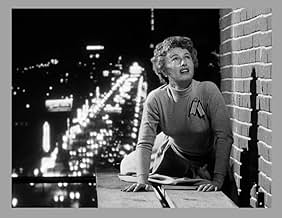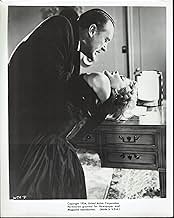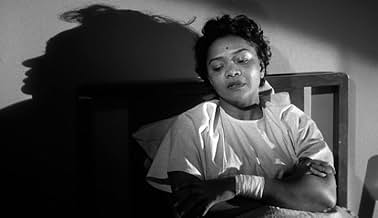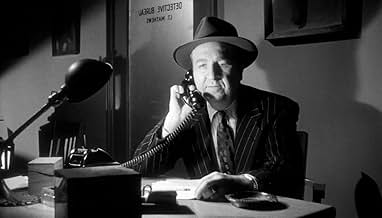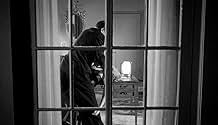NOTE IMDb
6,6/10
3,7 k
MA NOTE
Ajouter une intrigue dans votre langueA woman's sanity comes into question after she claims to have witnessed a murder from her apartment window.A woman's sanity comes into question after she claims to have witnessed a murder from her apartment window.A woman's sanity comes into question after she claims to have witnessed a murder from her apartment window.
- Réalisation
- Scénario
- Casting principal
Adeline De Walt Reynolds
- The Old Lady
- (as Adeline de Walt Reynolds)
Claude Akins
- Police Officer
- (non crédité)
Ralph Brooks
- Man at Lunch Counter
- (non crédité)
Russell Custer
- Police Officer
- (non crédité)
Sam Edwards
- Tommy
- (non crédité)
Jean Fenwick
- Nurse
- (non crédité)
Fred Graham
- Plainclothes Man
- (non crédité)
Avis à la une
The John Alton photography is layered thick and shadowy in this late Film-Noir entry. Almost every scene is back lit with diagonals and impressions draping the proceedings and it is this atmospheric artistic display that highlights this often filmed story.
The characters and conventions of the Noir cycle by this time have become familiar but the shear broad strokes of the style are undeniably effective. The odd take on the villain being of Nazi descent with delusions of grandeur while meant to be of a deep personality flaw, is obtrusive and distracts from believability. It is an unwanted and unneeded take on the psychological persona of the killer.
The mental hospital scene is a standout as is the finale through the construction site. The only drag is the relentless unbelieving of the authorities that wears out its welcome fast but in the long view does not hold the film back from its better parts.
The characters and conventions of the Noir cycle by this time have become familiar but the shear broad strokes of the style are undeniably effective. The odd take on the villain being of Nazi descent with delusions of grandeur while meant to be of a deep personality flaw, is obtrusive and distracts from believability. It is an unwanted and unneeded take on the psychological persona of the killer.
The mental hospital scene is a standout as is the finale through the construction site. The only drag is the relentless unbelieving of the authorities that wears out its welcome fast but in the long view does not hold the film back from its better parts.
In addition to its solid performances, tight storytelling and John Alton's superior cinematography, what makes "Witness to Murder" particularly powerful today is the movie's pre-feminist view of its leading character's dilemma. "But I saw the murder, I SAW the murder," the Stanwyck character insists. Yet no one believes her because 1) she's a woman; 2) she's unmarried; 3) she's menopausal. Nobody even blinks an eye when she's dumped in a mental hospital, which gets viewers really riled because they share her point of view. The audience sees the murder along with Stanwyck and can feel her humiliation, anger and frustration. That's why the movie works.
Barbara Stanwyck witnesses a murder and the culprit, played by the usually sinister George Sanders, is trying to drive her insane after this event. Gary Merrill is the detective who tries to sort this all out while he is falling for Cheryl (Barbara).
The flaw here is in the writing. Sanders, as Mr. Richter, should have immediately been under much more suspicion as he was a former Nazi who came into this country legally. Who can believe that one? In addition, he is an author whose books justify the deaths of certain people. Sounds horribly familiar to me.
Stanwyck gives her usually good performance as a tormented woman who is driven mad by Richter.
The roof scene finale is exciting but comes too late following big errors in the movie writing.
The flaw here is in the writing. Sanders, as Mr. Richter, should have immediately been under much more suspicion as he was a former Nazi who came into this country legally. Who can believe that one? In addition, he is an author whose books justify the deaths of certain people. Sounds horribly familiar to me.
Stanwyck gives her usually good performance as a tormented woman who is driven mad by Richter.
The roof scene finale is exciting but comes too late following big errors in the movie writing.
This is a great example of "film noir," as every scene has some sort of shadow pattern on the wall, the floor, the faces. All shots are done with key light on the faces. The patterns suggest "jail," "locked up," "flight" (as in a train track), "trapped," (as in a cobweb), and others. There isn't one scene that doesn't have a shadow in it! Even the day time sequences. And the actors that had great careers: Stanwyck, Gary Merrill, Claude Akins, even Jesse (the original maytag repairman) White, and, of course, George Sanders, who plays a "deNazified" ex-Nazi. Whew! Great stuff.
It's interesting that both this film and "Rear Window" came out in the same year, since the base plot is identical: person witnessess murder through apartment window in opposing apartment and spends rest of movie trying to convince everone else what they saw. While the Hitchcock movie is more stylish and elaborate, this film definitely keeps your attention. Typical of movies of the 50's, the villain is disposed of in the climax, thereby eliminating any necessity of bringing them to justice. Stanwyck, as usual, gives her best "woman in distress", hysterical performance.
Le saviez-vous
- AnecdotesIn an unusual connection for the time (or possibly a product placement), the W&J Sloane Company in Beverly Hills - where Cheryl worked - was a real furniture and interior decorating firm founded in New York City in 1843. It went bankrupt in 1985. According to the end credits, the company supplied set decorations and furnishings for the film.
- GaffesThe story is taking place in Los Angeles, but the map on the wall in Larry's office is that of San Francisco.
- Citations
[repeated line]
The Old Lady - Mental Patient: Show Mr. Peabody into the library please.
- ConnexionsFeatured in Frances Farmer Presents: Witness to Murder (1959)
Meilleurs choix
Connectez-vous pour évaluer et suivre la liste de favoris afin de recevoir des recommandations personnalisées
Détails
- Date de sortie
- Pays d’origine
- Langues
- Aussi connu sous le nom de
- Testigo del crimen
- Lieux de tournage
- Linda Vista Apartments, 939 S. Serrano Ave., Los Angeles, Californie, États-Unis(Cheryl Draper's apartment building)
- Société de production
- Voir plus de crédits d'entreprise sur IMDbPro
- Durée
- 1h 23min(83 min)
- Couleur
- Rapport de forme
- 1.75 : 1
Contribuer à cette page
Suggérer une modification ou ajouter du contenu manquant

![Regarder Trailer [EN]](https://m.media-amazon.com/images/M/MV5BYjI4NDBiYmQtN2U0MS00MTdjLWI0YzEtODBkYjE0YjQ1MDc4XkEyXkFqcGdeQXRyYW5zY29kZS13b3JrZmxvdw@@._V1_QL75_UX500_CR0)
